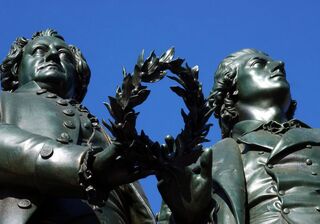
Goethe & Schiller Monument
If we had to name just one symbol for Weimar, it would doubtless be Ernst Rietschel's statue of Goethe and Schiller, which has stood on Theaterplatz since 1857. Interestingly, their eyes are at almost the same height - yet do not meet. Copies of the statue can be seen in Cleveland, Milwaukee and San Francisco - and now also in Shanghai. The inscription reads: "THE TWO POETS GOETHE AND SCHILLER THE FATHERLAND"
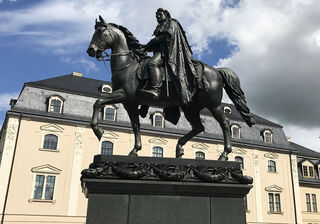
Carl-August Monument
Head and shoulders above the common people as befitting his rank, Grand Duke Carl August (1757-1828) towers above Platz der Demokratie in front of Fürstenhaus. Although the foundations for the statue were laid to mark the centenary of Carl August's birth, it was only completed eighteen years later. Carl August did much to encourage popular culture and science, paving the way for Weimar's cosmopolitan development.
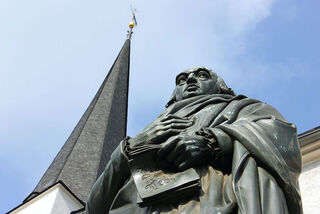
Herder Monument
It was Weimar's first monument for a poet and was unveiled on Herder's 16th birthday at the former pottery market in front of the City Church St. Peter and Paul (where Herder had worked). Johann Gottfried Herder, philosopher and theologian (1744-1803), was appointed to the position of General Superintendent of the churches in the Duchy of Saxony-Weimar upon Goethe's recommendation in 1776. The bronze figure was cast according to Ludwig Schaller's design (1848).
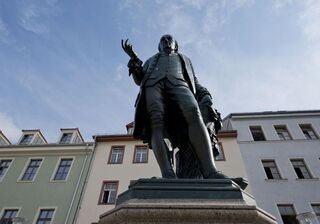
Wieland Monument
Christoph Martin Wieland (1733-1813) was one of the 18th century’s most successful writers, and earned acclaim as a narrative poet, novelist, translator, editor, publisher and journalist. His works attracted the attention of Anna Amalia and resulted in his appointment as tutor to her two sons. Weimar and his estate in Oßmannstedt near Weimar remained Wieland's home until his death.
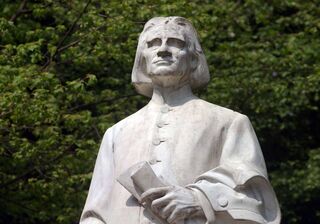
Liszt Monument
Franz Liszt (1811-86) made Weimar a centre of music of European renown when he was director of music extraordinary to the Weimar court. He reshaped the town's musical life and influenced its Silver Age. And it was in Weimar that Liszt conducted the first ever performance of Wagner's Lohengrin.
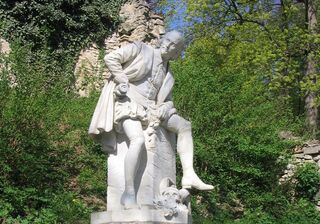
Shakespeare Monument
William Shakespeare (1564-1616) is popularly known as the 'third German classic'. In fact Goethe himself learned the high art of poetry from his English role model. The statue by Otto Lessing from Berlin (the only statue of Shakespeare in Germany) was unveiled in the Park on the Ilm in 1904.
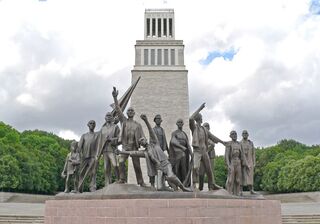
Buchenwald plastic
The famous statue at Buchenwald by Fritz Cremer is part of the Buchenwald Memorial complex, the biggest and foremost monument commemorating a concentration camp anywhere in Germany. Made in 1954-58, the group was restored in 2002-05. The larger-than-life bronze figures symbolise combat and victim, victory and vow.
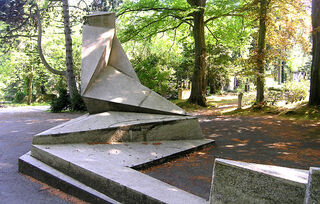
Monument to the March Dead
In 1920, Walter Gropius submitted his "lightning strike" as "symbol of the living spirit" for a competition tendered by the Städtisches Museum Weimar. The Denkmal der Märzgefallenen (Monument to the March Dead) was designed to commemorate the victims of the Kapp Putsch of March 1920. Two years later, Gropius's monument was erected in the main cemetery in Weimar.
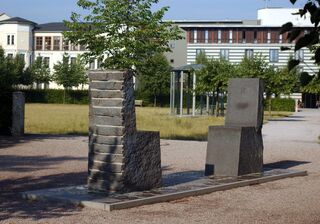
Hafis-Goethe Monument
"Those who know themselves and others will also realise that Orient and Occident can no longer be separated." Unveiled in the year 2000, the two chairs recall Goethe's encounter with the works of the Persian national poet Hafis (1326-1390) and symbolises cultural tolerance.
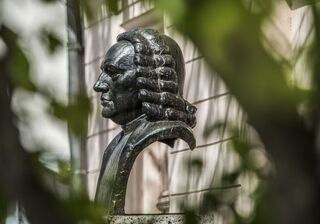
Bach Monument
The statue of J.S. Bach was first unveiled in 1950 but removed two years later, before finally being re-erected on Platz der Demokratie in 1995. The link between the works of Bach (1685-1750) and Weimar is not generally known. Nevertheless, the composer lived in Weimar from 1708 until 1717, and two of his sons were born here. When Bach tendered his resignation as concertmaster, he was imprisoned by his employer, Duke Wilhelm, for nearly four weeks.
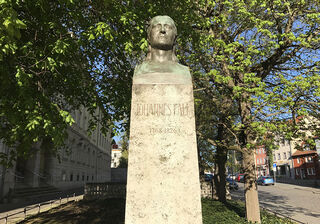
Johannes-Falk Monument
The statue of social education and writer Johannes Falk (1768-1826) was unveiled to mark the centenary of the Society of Friends in Need. Although his literature has almost completely faded into obscurity, his Christmas carol 'O du fröhliche' is sung all over the world. His work looking after disadvantaged children is still continued by the Falk Association.
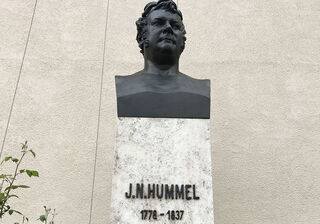
Hummel Monument
Composer and virtuoso pianist Johann Nepomuk Hummel (1778-1837) was employed at Duke Carl August's court, where he became the most famous capellmeister in Goethe's day. One of the most highly respected pianists of his age, Hummer was also a close friend of Ludwig van Beethoven.
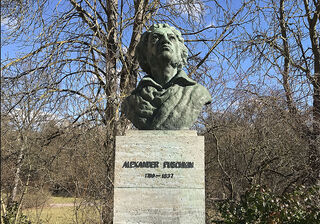
Puschkin Monument
Pushkin (1799-1837), Russian's greatest poet and the founder of modern Russian literature, was an ardent aficionado of Goethe and was himself greatly admired in Germany. A statue was erected to Pushkin in 1949 on the edge of the park next to the library tower to commemorate the 150th anniversary of his birth.
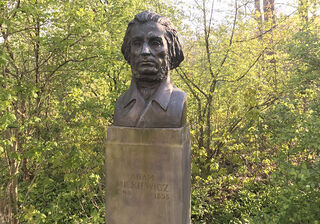
Mickiewicz Monument
In 1956, a monument was erected near the bank of the River Ilm in honour of the national poet and passionate admirer of classical German literature Adam Mickiewicz (1798-1855). Mickiewicz was the principal poet of Polish Romanticism. In August 1829 he was an invited guest at the celebrations for Goethe's eightieth birthday in Weimar.
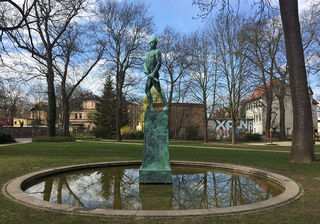
Wildenbruch Monument
When this monument disappeared in 1976, the principal reason was doubtless its inscription: "I fight not in order to attack but to defend." It was thanks to a local society that this sculpture of an antique warrior in honour of dramatist Ernst von Wildenbruch (1845-1909) was crafted by Richard Engelmann, an artist of Jewish descent who taught at Weimar School of Art. The monument was one of Engelmann's largest pieces of sculpture.
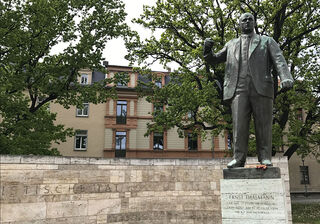
Ernst-Thälmann Monument
The statue of Ernst Thälmann unveiled in 1958 and the surrounding square named after him also commemorate the more than 56,000 people who died at Buchenwald concentration camp. Ernst Thälmann (1886-44) was the leader of the German Communist Party and a member of the Reichstag from 1924 until 1933. Subsequently imprisoned in Buchenwald, he was murdered there in 1944.
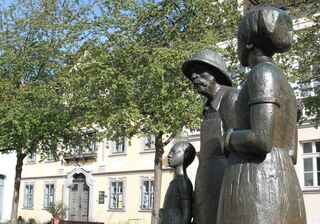
Albert Schweitzer Monument
The first statue in the world of German humanist Albert Schweitzer (1875-1965) was erected in the East German era on behalf of the Christian Democrats. Weimar was chosen (as well as for the Albert Schweitzer Memorial and Social Centre) by the Albert Schweitzer Committee since Albert Schweitzer's personality and life had been characterised by humanity.
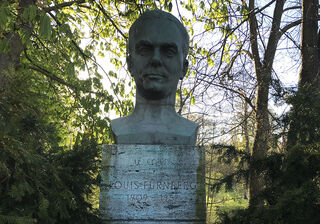
Louis Fürnberg Monument
Louis Fürnberg (1909-57) began his literary career in the 1920s in Czechoslovakia by writing poems against the newly emerging National Socialism. He came to East Germany in 1951 as ambassador before moving to Weimar in 1954. Fürnberg was a co-founder of the literary journal Weimarer Beiträge ('Weimar Articles'). The bust was unveiled in 1961 to mark his fifty-second birthday.
Anzeigen